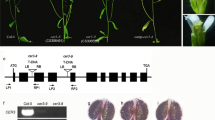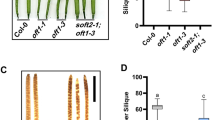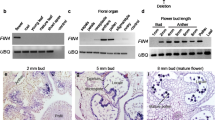Abstract
We isolated lap3-1 and lap3-2 mutants in a screen for pollen that displays abnormal stigma binding. Unlike wild-type pollen, lap3-1 and lap3-2 pollen exine is thinner, weaker, and is missing some connections between their roof-like tectum structures. We describe the mapping and identification of LAP3 as a novel gene that contains a repetitive motif found in β-propeller enzymes. Insertion mutations in LAP3 lead to male sterility. To investigate possible roles for LAP3 in pollen development, we assayed the metabolite profile of anther tissues containing developing pollen grains and found that the lap3-2 defect leads to a broad range of metabolic changes. The largest changes were seen in levels of a straight-chain hydrocarbon nonacosane and in naringenin chalcone, an obligate compound in the flavonoid biosynthesis pathway.




Similar content being viewed by others
References
Aarts MG, Hodge R, Kalantidis K, Florack D, Wilson ZA, Mulligan BJ, Stiekema WJ, Scott R, Pereira A (1997) The Arabidopsis MALE STERILITY 2 protein shares similarity with reductases in elongation/condensation complexes. Plant J 12:615–623
Ahlers F, Thom L, Lambert J, Kuckuk R, Wiermann R (1999) NMR analysis of sporopollenin from Typha augustifolia. Phytochemistry 5:1095–1098
Ahlers F, Bubert H, Steuernagel S, Wiermann R (2000) The nature of oxygen in sporopollenin from the pollen of Typha angustifolia L. Z Naturforsch C J Biosci 55:129–136
Ahlers F, Lambert J, Wiermann R (2003) Acetylation and silylation of piperidine solubilized sporopollenin from pollen of Typha angustifolia L. Z Naturforsch C J Biosci 58:807–811
Alonso JM, Stepanova AN, Leisse TJ, Kim CJ, Chen H, Shinn P, Stevenson DK, Zimmerman J, Barajas P, Cheuk R, Gadrinab C, Heller C, Jeske A, Koesema E, Meyers CC, Parker H, Prednis L, Ansari Y, Choy N, Deen H, Geralt M, Hazari N, Hom E, Karnes M, Mulholland C, Ndubaku R, Schmidt I, Guzman P, Aguilar-Henonin L, Schmid M, Weigel D, Carter DE, Marchand T, Risseeuw E, Brogden D, Zeko A, Crosby WL, Berry CC, Ecker JR (2003) Genome-wide insertional mutagenesis of Arabidopsis thaliana. Science 301:653–657
Ariizumi T, Toriyama K (2007) Pollen exine pattern formation is dependent on three major developmental processes in Arabidopsis thaliana. Int J Plant Dev Biol 1:106–115
Ariizumi T, Hatakeyama K, Hinata K, Sato S, Kato T, Tabata S, Toriyama K (2003) A novel male-sterile mutant of Arabidopsis thaliana, faceless pollen-1, produces pollen with a smooth surface and an acetolysis-sensitive exine. Plant Mol Biol 53:107–116
Ariizumi T, Hatakeyama K, Hinata K, Inatsugi R, Nishida I, Sato S, Kato T, Tabata S, Toriyama K (2004) Disruption of the novel plant protein NEF1 affects lipid accumulation in the plastids of the tapetum and exine formation of pollen, resulting in male sterility in Arabidopsis thaliana. Plant J 39:170–181
Ariizumi T, Hatakeyama K, Hinata K, Sato S, Kato T, Tabata S, Toriyama K (2005) The HKM gene, which is identical to the MS1 gene of Arabidopsis thaliana, is essential for primexine formation and exine pattern formation. Sex Plant Reprod 18:1–7
Ariizumi T, Kawanabe T, Hatakeyama K, Sato S, Kato T, Tabata S, Toriyama K (2008) Ultrastructural characterization of exine development of the transient defective exine 1 mutant suggests the existence of a factor involved in constructing reticulate exine architecture from sporopollenin aggregates. Plant Cell Physiol 49:58–67
Bolick MR, Vogel S (1992) Breaking strengths of pollen grain walls. Plant Syst Evol 181:171–178
Boyes DC, Zayed AM, Ascenzi R, McCaskill AJ, Hoffman NE, Davis KR, Gorlach J (2001) Growth stage-based phenotypic analysis of arabidopsis: a model for high throughput functional genomics in plants. Plant Cell 13:1499–1510
Broeckling CD, Huhman DV, Farag MA, Smith JT, May GD, Mendes P, Dixon RA, Sumner LW (2005) Metabolic profiling of Medicago truncatula cell cultures reveals the effects of biotic and abiotic elicitors on metabolism. J Exp Bot 56:323–336
Bubert H, Lambert J, Steuernagel S, Ahlers F, Wiermann R (2002) Continuous decomposition of sporopollenin from pollen of Typha angustifolia L. by acidic methanolysis. Z Naturforsch C J Biosci 57:1035–1041
Burbulis IE, Iacobucci M, Shirley BW (1996) A null mutation in the first enzyme of flavonoid biosynthesis does not affect male fertility in Arabidopsis. Plant Cell 8:1013–1025
Cigan AM, Unger E, Xu RJ, Kendall T, Fox TW (2001) Phenotypic complementation of ms45 maize requires tapetal expression of MS45. Sex Plant Reprod 14:135–142
Clough SJ, Bent AF (1998) Floral dip: a simplified method for Agrobacterium-mediated transformation of Arabidopsis thaliana. Plant J 16:735–743
Coe EH, McCormick SM, Modena SA (1981) White pollen in maize. J Hered 72:318–320
Cox ED, Cook JM (1995) The Pictet-Spengler condensation—a new direction for an old reaction. Chem Rev 95:1797–1842
Dominguez E, Mercado JA, Quesada MA, Heredia A (1999) Pollen sporopollenin: degradation and structural elucidation. Sex Plant Reprod 12:171–178
Dong XY, Hong ZL, Sivaramakrishnan M, Mahfouz M, Verma DPS (2005) Callose synthase (CalS5) is required for exine formation during microgametogenesis and for pollen viability in Arabidopsis. Plant J 42:315–328
Fox TW, Trimnell MR, Albertsen MC (2001) Cloning of Ms45, a gene required for male fertility from Zea mays. Trait and Technology Development, Pioneer Hi-Bred Intl. Inc. (direct submission)
Franken P, Niesbachklosgen U, Weydemann U, Marechaldrouard L, Saedler H, Wienand U (1991) The duplicated chalcone synthase genes C2 and Whp (white pollen) of Zea mays are independently regulated—evidence for translational control of Whp expression by the anthocyanin intensifying gene (in). EMBO J 10:2605–2612
Guan YF, Huang XY, Zhu J, Gao JF, Zhang HX, Yang ZN (2008) RUPTURED POLLEN GRAIN1, a member of the MtN3/saliva gene family, is crucial for exine pattern formation and cell integrity of microspores in Arabidopsis. Plant Physiol 147:852–863
Guilford WJ, Schneider DM, Labovitz J, Opella SJ (1988) High resolution solid state 13C NMR spectroscopy of sporopollenins from different plant taxa. Plant Physiol 86:134–136
Hannoufa A, McNevin J, Lemieux B (1993) Epicuticular waxes of eceriferum mutants of Arabidopsis thaliana. Phytochemistry 33:851–855
Hellens RP, Edwards EA, Leyland NR, Bean S, Mullineaux PM (2000) pGreen: a versatile and flexible binary Ti vector for Agrobacterium-mediated plant transformation. Plant Mol Biol 42:819–832
Hemsley AR, Barrie PJ, Chaloner WG, Scott AC (1993) The composition of sporopollenin and its use in living and fossil plant systematics. Grana 1:2–11
Hsieh K, Huang AHC (2007) Tapetosomes in Brassica tapetum accumulate endoplasmic reticulum-derived flavonoids and alkanes for delivery to the pollen surface. Plant Cell 19:582–596
Jawad Z, Paoli M (2002) Novel sequences propel familiar folds. Structure 10:447–454
Kawase M, Takahashi M (1995) Chemical-composition of sporopollenin in Magnolia grandiflora (Magnoliaceae) and Hibiscus syriacus (Malvaceae). Grana 34:242–245
Koepke J, Ma XY, Fritzsch U, Michel H, Stockigt J (2005) Crystallization and preliminary X-ray analysis of strictosidine synthase and its complex with the substrate tryptamine. Acta Crystallogr D Biol Crystallogr 61:690–693
Kutchan TM (1993) Strictosidine—from alkaloid to enzyme to gene. Phytochemistry 32:493–505
Larkin MA, Blackshields G, Brown NP, Chenna R, McGettigan PA, McWilliam H, Valentin F, Wallace IM, Wilm A, Lopez R, Thompson JD, Gibson TJ, Higgins DG (2007) Clustal W and clustal X version 2.0. Bioinformatics 23:2947–2948
Loris EA, Panjikar S, Ruppert M, Barleben L, Unger M, Schubel H, Stockigt J (2007) Structure-based engineering of strictosidine synthase: auxiliary for alkaloid libraries. Chem Biol 14:979–985
Ma XY, Koepke J, Fritzsch G, Diem R, Kutchan TM, Michel H, Stockigt J (2004) Crystallization and preliminary X-ray crystallographic analysis of strictosidine synthase from Rauvolfia: the first member of a novel enzyme family. Biochim Biophys Acta Proteins Proteomics 1702:121–124
Ma XY, Panjikar S, Koepke J, Loris E, Stockigt J (2006) The structure of Rauvolfia serpentina strictosidine synthase is a novel six-bladed beta-propeller fold in plant proteins. Plant Cell 18:907–920
Meutergerhards A, Schwerdtfeger C, Steuernagel S, Wilmesmeier S, Wiermann R (1995) Studies on sporopollenin structure during pollen development. Z Naturforsch C J Biosci 50:487–492
Meuter-Gerhards A, Riegert S, Wiermann R (1999) Studies of sporopollenin biosynthesis in Cucurbita maxima-II. The involvement of aliphatic metabolism. J Plant Physiol 154:431–436
Meyers BC, Lee DK, Vu TH, Tej SS, Edberg SB, Matvienko M, Tindell LD (2004) Arabidopsis MPSS. An online resource for quantitative expression analysis. Plant Physiol 135:801–813
Morant M, Jorgensen K, Schaller H, Pinot F, Moller BL, Werck-Reichhart D, Bak S (2007) CYP703 is an ancient cytochrome P450 in land plants catalyzing in-chain hydroxylation of lauric acid to provide building blocks for sporopollenin synthesis in pollen. Plant Cell 19:1473–1487
Napoli CA, Fahy D, Wang HY, Taylor LP (1999) White anther: a petunia mutant that abolishes pollen flavonol accumulation, induces male sterility, and is complemented by a chalcone synthase transgene. Plant Physiol 120:615–622
Nishikawa S-i, Zinkl GM, Swanson R, Maruyama D, Preuss D (2005) Callose (β-1, 3 glucan) is essential for Arabidopsis pollen wall patterning, but not tube growth. BMC Plant Biol 5:1–9
Paxson-Sowders DM, Owen HA, Makaroff CA (1997) A comparative ultrastructural analysis of exine pattern development in wild-type Arabidopsis and a mutant defective in pattern formation. Protoplasma 198:53–65
Paxson-Sowders DM, Dodrill CH, Owen HA, Makaroff CA (2001) DEX1, a novel plant protein, is required for exine pattern formation during pollen development in Arabidopsis. Plant Physiol 127:1739–1749
Peschel S, Franke R, Schreiber L, Knoche M (2007) Composition of the cuticle of developing sweet cherry fruit. Phytochemistry 68:1017–1025
Pietta PG (2000) Flavonoids as antioxidants. J Nat Prod 63:1035–1042
Piffanelli P, Ross JHE, Murphy DJ (1998) Biogenesis and function of the lipidic structures of pollen grains. Sex Plant Reprod 11:65–80
Preuss D, Lemieux B, Yen G, Davis RW (1993) A conditional sterile mutation eliminates surface components from Arabidopsis pollen and disrupts cell signaling during fertilization. Genes Dev 7:974–985
Rowley JR, Skvarla JJ (2000) The elasticity of the exine. Grana 39:1–7
Scott RJ (1994) Pollen exine: the sporopollenin enigma and the physics of pattern. In: Scott RJ, Stead MA (eds) Molecular and cellular aspects of plant reproduction. Cambridge University Press, Cambridge, pp 49–81
Scott R, Hodge R, Paul W, Draper J (1991) The molecular-biology of anther differentiation. Plant Sci 80:167–191
Shirley BW, Kubasek WL, Storz G, Bruggemann E, Koornneef M, Ausubel FM, Goodman HM (1995) Analysis of Arabidopsis mutants deficient in flavonoid biosynthesis. Plant J 8:659–671
Smyth DR, Bowman JL, Meyerowitz EM (1990) Early flower development in Arabidopsis. Plant Cell 2:755–767
Southworth D (1974) Solubility of pollen exines. Am J Bot 61:36–44
Stockigt J, Barleben L, Panjikar S, Loris EA (2008) 3D-Structure and function of strictosidine synthase—the key enzyme of monoterpenoid indole alkaloid biosynthesis. Plant Physiol Biochem 46:340–355
Suzuki T, Masaoka K, Nishi M, Nakamura K, Ishiguro S (2008) Identification of kaonashi mutants showing abnormal pollen exine structure in Arabidopsis thaliana. Plant Cell Physiol 49(146):5–77
Vandermeer IM, Stam ME, Vantunen AJ, Mol JNM, Stuitje AR (1992) Antisense inhibition of flavonoid biosynthesis in petunia anthers results in male-sterility. Plant Cell 4:253–262
von Besser K, Frank AC, Johnson MA, Preuss D (2006) Arabidopsis HAP2 (GCS1) is a sperm-specific gene required for pollen tube guidance and fertilization. Development 133:4761–4769
Worrall D, Hird DL, Hodge R, Paul W, Draper J, Scott R (1992) Premature dissolution of the microsporocyte callose wall causes male-sterility in transgenic tobacco. Plant Cell 4:759–771
Zimmermann P, Hirsch-Hoffmann M, Hennig L, Gruissem W (2004) GENEVESTIGATOR. Arabidopsis microarray database and analysis toolbox. Plant Physiol 136:2621–2632
Zinkl GM, Preuss D (2000) Dissecting Arabidopsis pollen-stigma interactions reveals novel mechanisms that confer mating specificity. Ann Bot 85:15–21
Zinkl GM, Zwiebel BI, Grier DG, Preuss D (1999) Pollen-stigma adhesion in Arabidopsis: a species-specific interaction mediated by lipophilic molecules in the pollen exine. Development 126:5431–5440
Acknowledgment
This work was supported by a grant from the National Science Foundation MCB-0520283.
Author information
Authors and Affiliations
Corresponding author
Additional information
Communicated by David Twell.
Electronic supplementary material
Below is the link to the electronic supplementary material.
Rights and permissions
About this article
Cite this article
Dobritsa, A.A., Nishikawa, SI., Preuss, D. et al. LAP3, a novel plant protein required for pollen development, is essential for proper exine formation. Sex Plant Reprod 22, 167–177 (2009). https://doi.org/10.1007/s00497-009-0101-8
Received:
Accepted:
Published:
Issue Date:
DOI: https://doi.org/10.1007/s00497-009-0101-8




